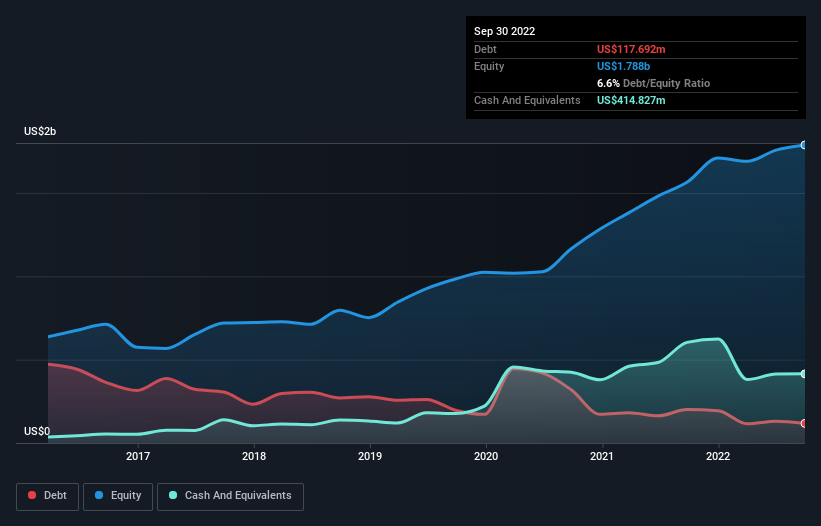Stock Analysis

David Iben put it well when he said, 'Volatility is not a risk we care about. What we care about is avoiding the permanent loss of capital.' So it might be obvious that you need to consider debt, when you think about how risky any given stock is, because too much debt can sink a company. We note that Graco Inc. (NYSE:GGG) does have debt on its balance sheet. But the more important question is: how much risk is that debt creating?
Why Does Debt Bring Risk?
Debt and other liabilities become risky for a business when it cannot easily fulfill those obligations, either with free cash flow or by raising capital at an attractive price. Ultimately, if the company can't fulfill its legal obligations to repay debt, shareholders could walk away with nothing. However, a more usual (but still expensive) situation is where a company must dilute shareholders at a cheap share price simply to get debt under control. Having said that, the most common situation is where a company manages its debt reasonably well - and to its own advantage. The first step when considering a company's debt levels is to consider its cash and debt together.
View our latest analysis for Graco
How Much Debt Does Graco Carry?
You can click the graphic below for the historical numbers, but it shows that Graco had US$117.7m of debt in September 2022, down from US$200.3m, one year before. However, its balance sheet shows it holds US$414.8m in cash, so it actually has US$297.1m net cash.

How Strong Is Graco's Balance Sheet?
We can see from the most recent balance sheet that Graco had liabilities of US$430.8m falling due within a year, and liabilities of US$219.1m due beyond that. On the other hand, it had cash of US$414.8m and US$364.1m worth of receivables due within a year. So it actually has US$129.0m more liquid assets than total liabilities.
Having regard to Graco's size, it seems that its liquid assets are well balanced with its total liabilities. So it's very unlikely that the US$11.3b company is short on cash, but still worth keeping an eye on the balance sheet. Simply put, the fact that Graco has more cash than debt is arguably a good indication that it can manage its debt safely.
Fortunately, Graco grew its EBIT by 7.4% in the last year, making that debt load look even more manageable. The balance sheet is clearly the area to focus on when you are analysing debt. But it is future earnings, more than anything, that will determine Graco's ability to maintain a healthy balance sheet going forward. So if you want to see what the professionals think, you might find this free report on analyst profit forecasts to be interesting.
Finally, a business needs free cash flow to pay off debt; accounting profits just don't cut it. While Graco has net cash on its balance sheet, it's still worth taking a look at its ability to convert earnings before interest and tax (EBIT) to free cash flow, to help us understand how quickly it is building (or eroding) that cash balance. During the last three years, Graco produced sturdy free cash flow equating to 59% of its EBIT, about what we'd expect. This free cash flow puts the company in a good position to pay down debt, when appropriate.
Summing Up
While we empathize with investors who find debt concerning, you should keep in mind that Graco has net cash of US$297.1m, as well as more liquid assets than liabilities. So we don't think Graco's use of debt is risky. When analysing debt levels, the balance sheet is the obvious place to start. However, not all investment risk resides within the balance sheet - far from it. For example - Graco has 1 warning sign we think you should be aware of.
If, after all that, you're more interested in a fast growing company with a rock-solid balance sheet, then check out our list of net cash growth stocks without delay.
New: Manage All Your Stock Portfolios in One Place
We've created the ultimate portfolio companion for stock investors, and it's free.
• Connect an unlimited number of Portfolios and see your total in one currency
• Be alerted to new Warning Signs or Risks via email or mobile
• Track the Fair Value of your stocks
Have feedback on this article? Concerned about the content? Get in touch with us directly. Alternatively, email editorial-team (at) simplywallst.com.
This article by Simply Wall St is general in nature. We provide commentary based on historical data and analyst forecasts only using an unbiased methodology and our articles are not intended to be financial advice. It does not constitute a recommendation to buy or sell any stock, and does not take account of your objectives, or your financial situation. We aim to bring you long-term focused analysis driven by fundamental data. Note that our analysis may not factor in the latest price-sensitive company announcements or qualitative material. Simply Wall St has no position in any stocks mentioned.
About NYSE:GGG
Graco
Designs, manufactures, and markets systems and equipment used to move, measure, control, dispense, and spray fluid and powder materials worldwide.
Flawless balance sheet with proven track record and pays a dividend.

